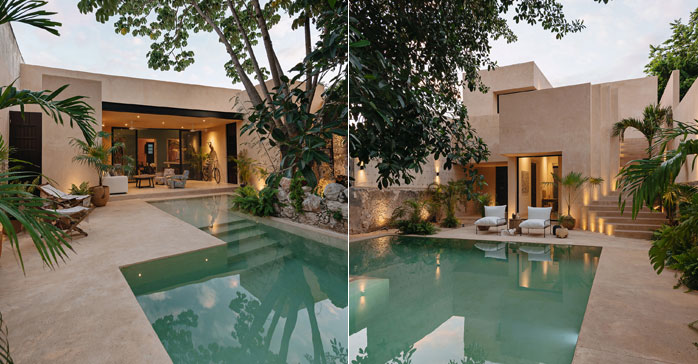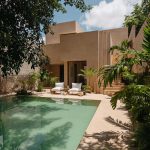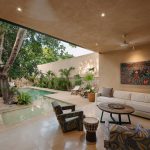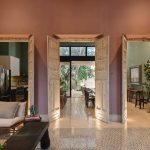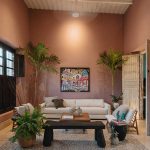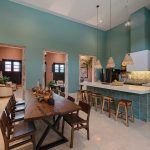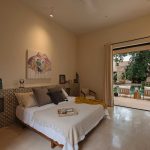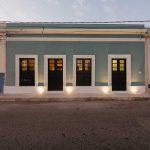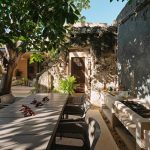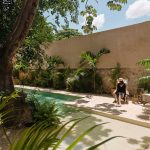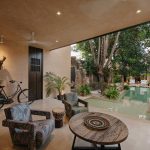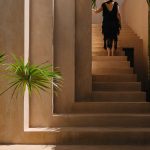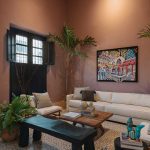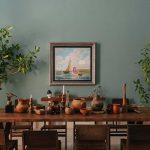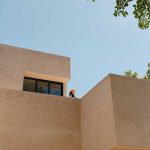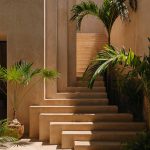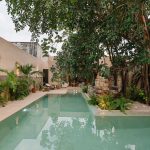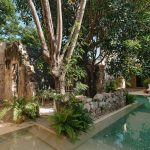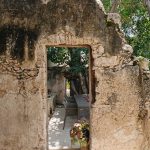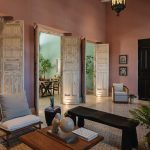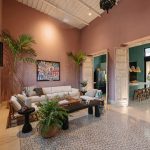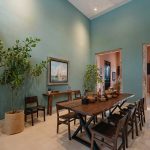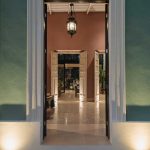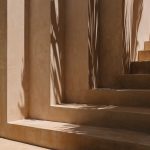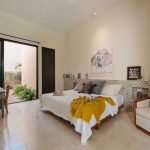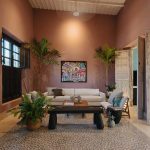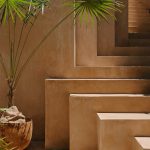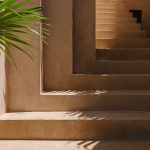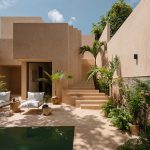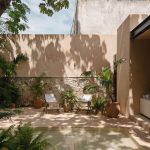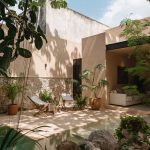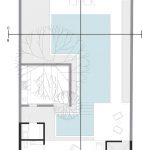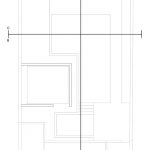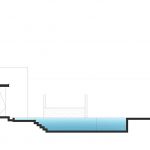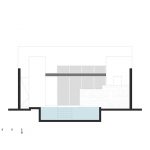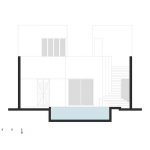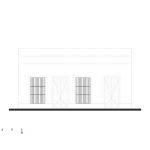Casa Houlpoch (Mérida, Yucatán, México) por Workshop Diseño y Construcción. Casa Houlpoch es una antigua casona Yucateca de finales del siglo pasado que obtiene su nombre por una serpiente de la región que «visitaba» regularmente las ruinas de la propiedad. Detrás de su fachada colonial, esta vivienda alberga cuatro habitaciones y un departamento tipo estudio, con un total de 315 metros cuadrados de construcción. Al acceder al recibidor, nos da la bienvenida una antigua lámpara de hierro fundido (muy común de observar en las casonas decimonónicas de la ciudad) que cuelga de las vigas metálicas originales y que junto con las viguetillas de madera en color blanco engalanan los altos techos de la residencia.
La sala, en tonos pasteles, cuenta con mobiliario moderno y casual, integrando vegetación y obras de arte, como un juguetón Timoteo en la mesa central y un cuadro de Pedro Friedeberg sobre el sofá, coronando el espacio. El tapete de mosaicos de pasta en color gris, son rodeados por un borde de piso en color blanco antiguo que se une a la cocina y al comedor a través de tres antiguas puertas coloniales que fueron reutilizadas, tal cual se encontraron, conservando su carácter y su valor histórico.
La cocina, con recubrimientos en pasta y cuarzo, cuenta con una reinterpretación de las antiguas campanas yucatecas sobre la estufa. Las lámparas colgantes, de Axoque Studio, armonizan el espacio y se integran al mobiliario de madera como los bancos de tzalam y al comedor, el cual que fue traído desde Mozambique, país donde residieron los propietarios neerlandeses antes de establecerse en la península yucateca.
El comedor se conecta a la terraza por medio de un ventanal, generando una sensación de amplitud y claridad donde las visuales se fugan hacia los exteriores. Es en este último espacio donde por medio de la decoración y el mobiliario, convergen las tres culturas con las que se identifican los propietarios, la mesa, su centro de mesa, y el tambor, fueron traídos desde Mozambique, así como los patrones en tela que envuelven dos sillas Utrecht del diseñador y arquitecto neerlandés Gerrit Rietvelt. Sobre el sofá descansa un cuadro del artista mexicano Fernando Andriacci y del lado opuesto destaca como elemento decorativo una cabeza de vaca adornada con cuentas del arte huichol y justo debajo una tradicional bicicleta holandesa con los colores de la Prinsenvlag.
En el patio central, una piscina de chukum rodea los vestigios en piedra de una antigua estructura colonial donde un gran árbol de álamo genera con su fronda un espectacular juego de luces y sombras, creando la atmósfera perfecta para albergar una cocina al aire libre.
La parte pública y privada de la casa se conectan simbólicamente por medio de la barda perimetral que juega con dos texturas diferentes, por un lado, tenemos la albarrada de piedra original en la parte inferior, y en la parte superior un muro nuevo con acabado de chukum, enlazando el pasado con el presente.
La volumetría de la parte posterior de la propiedad se lee como un diseño totalmente disruptivo con respecto a la parte histórica de la residencia en donde los escalones al segundo nivel (donde se encuentran dos habitaciones y una terraza) fungen como como eje visual y como elemento escultórico, convirtiéndose en el sello distintivo de su arquitectura por su dinamismo.
El «serpenteo» con el que inician las escaleras de Casa Houlpoch toma como inspiración la milenaria escalinata del antiguo templo de Kukulkán (Serpiente emplumada y dios en la mitología maya) en Chichén Itzá, donde en cada equinoccio se puede observar como la deidad (formada por efectos de la luz y la sombra que se genera), desciende desde la parte superior del templo.
Con un diseño mucho más sencillo, la recámara principal en el primer nivel, cuenta con una cabecera hecha de pisos de pasta sobre la cual descansa un cuadro de Neon Caron. Las visuales desde la cama, se fugan hacia los exteriores gracias al uso de ventanales en dos extremos opuestos del espacio, el primero con vista a un jardín interior y el segundo que se oculta por completo en los muros, con vista a la alberca y a los jardines tropicales.
En Casa Houlpoch se busca respetar y rescatar los valores históricos de la arquitectura colonial yucateca, combinándolos con detalles y volumetrías contemporáneas; y con las comodidades de la vida actual, de una manera reinterpretativa, pura y sobria, creando diferentes atmósferas para relajarse, para convivir y para disfrutar de los exteriores en el cálido clima peninsular.
Ficha técnica
Nombre: Casa Huolpoch
Despacho: Workshop Diseño y Construcción
Ubicación: Mérida, Yucatán, México
Equipo: Arq. Francisco Bernés Aranda, Arq. Fabián Gutiérrez Cetina, Arq. Isabel Bargas Cicero, Ing. Alejandro Bargas Cicero
Diseño de interiores: Workshop Diseño y Construcción
Mobiliario: Artesano MX
Arte: Galería Urbana Blanquis
Superficie construida: 315 m2
Fecha de finalización: Junio 2021
Fotografía: Tamara Uribe
Contacto
https://www.workshop.com.mx
Facebook: workshop.arquitectos
Instagram: @workshop_arquitectos
English version
Casa Houlpoch is an old Yucatecan house from the end of the last century that gets its name from a snake from the region that regularly «visited» the property’s ruins.
Behind its colonial facade, this house accommodates four bedrooms and a studio apartment, with a total of 315 square meters of construction.
Upon entering the hall, we are welcomed by an old cast iron lamp (very common to observe in the nineteenth-century houses of the city) that hangs from the original metal beams that together with the white wooden beams embellish the high ceilings of the residence.
The Livingroom, in pastel tones, has modern and casual furniture by Artesano, integrating greenery and pieces of art from Galería Urbana Blanquis, such as a playful Timoteo on the center table and a painting by Pedro Friedeberg above the sofa, crowning the space.
The gray pasta tile «carpet» is surrounded by an antique white floor border that joins the kitchen and dining room through three old colonial doors that were reused, as they were found, preserving their character and its historical value.
The kitchen, with finishings in pasta tile and white quartz, has a reinterpretation of the old Yucatecan hoods above the stove. The pendant lamps, by Axoque Studio, harmonize the space and integrate themselves into the wooden furniture such as the tzalam benches and the dining room table, which were brought from Mozambique, a country where the Dutch owners lived before settling in the Yucatan peninsula.
The dining room is connected to the terrace through a sliding glass door, generating a feeling of spaciousness and clarity where the visuals escape to the exterior. It is in this space where through decoration and furniture, the three cultures with which the owners identify themselves converge, the table, its centerpiece, and the drum, were brought from Mozambique, as well as the patterns on fabric that covers two Utrecht chairs by Dutch designer and architect Gerrit Rietvelt. On the sofa rests a painting by the Mexican artist Fernando Andriacci and on the opposite side a cow’s head adorned with beads of Huichol art stands out as a decorative element just above a traditional Dutch bicycle with the colors of the Prinsenvlag.
In the central courtyard, a chukum pool surrounds the stone remains of an old colonial structure where a large tree generates a spectacular play of light and shadow with its frond, creating the perfect atmosphere to host an outdoor kitchen.
The public and private parts of the house are symbolically connected by the perimeter fence that plays with two different textures, on one hand, we have the original stone brickwork in the lower part, and in the upper part a new wall finished with chukum, linking the past with the present.
The volumetry of the back of the property reads as a totally disruptive design from the historical part of the residence where the steps to the second level (where two rooms and a terrace are located) serve as a visual axis and as a sculptural element, becoming the hallmark of its architecture for its dynamism.
The «meandering» with which the Casa Houlpoch stairs begin takes as inspiration the millenary staircase of the ancient temple of Kukulkán (Feathered Serpent and god in Mayan mythology) in Chichén Itzá, where at each equinox it can be observed as the deity (formed due to the effects of the light and the shadow that is generated), descends from the upper part of the temple.
With a much simpler design, the master bedroom on the first level has a headboard made of pasta tiles on which a Neon Caron painting rests. The views from the bed, escape to the exterior thanks to the use of sliding glass doors at two opposite ends of the space, the first with a view of an interior garden and the second with a view of the pool.
At Casa Houlpoch we seek to respect and rescue the historical values ??of Yucatecan colonial architecture, combining them with contemporary details and volumes; and with the comforts of today’s life, in a reinterpretative, pure and sober way, creating different atmospheres to relax and to enjoy the outdoors in the warm peninsular climate.


